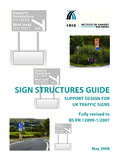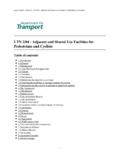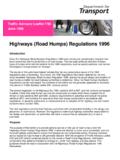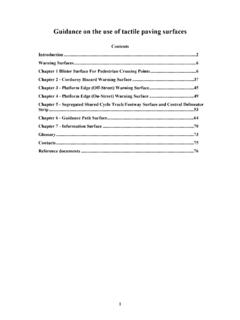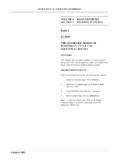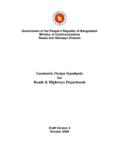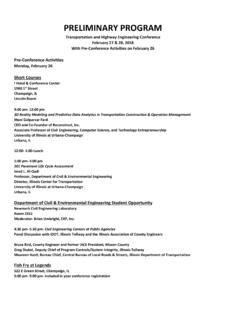Transcription of T DVISORY LEAFLET - UK Roads
1 T RAFFIC A DVISORY L EAFLET 5/05. Part 4 of 4. pedestrian Facilities at Signal-Controlled Junctions This LEAFLET is in four parts. This part includes Tables 1 and 2 referred to in parts 1 & 3 and the reference section TABLE 1. Advantages and disadvantages of alternative orientation at staggered crossings Stagger Advantages Disadvantages Left / right * Consistent with stand-alone crossings. Moves stop line and queue further from junction. Encourages pedestrians to face oncoming vehicles. May increase intergreens and therefore lost time if crossing Pedestrians on exit of junction are points, on all approaches, are nearer to the junction, improving not the same.
2 Intervisibility. If a stop line were needed for the crossing on exit it would be very close to junction. Right / left * Brings the stop line nearer to Not consistent with stand-alone the junction. crossings. Moves the exit crossing away from the Pedestrians not encouraged to "side road" and allows drivers of face oncoming vehicles whilst turning vehicles longer to assess walking between crossings. possible dangers. May cause problems with Allows possible stop line for exit intervisibility between "side road". crossing to be a reasonable distance and pedestrians.
3 From junction. * See layout drawings in Part 2. March 2005. Traffic Advisory Unit TABLE 2. Period Farside Nearside Vehicle Farside Nearside Period P pedestrian pedestrian Signal Period (seconds) (seconds). Signal Signal 1 Red Man Red Man Green Dependant upon Dependant upon cycle time. cycle time. 2 Red Man Red Man Amber 3 3. 3 Red Man Red Man Red Minimum to clear Minimum to clear traffic in the junction. traffic in the junction. 4* Green Man Green Man Red 6 - 12, depending 4-9. upon carriageway width and pedestrian density. 5 Black-out (No Red Man Red 3-15** 1-5**.)
4 Signal). 6 Red Man Red Man Red 1-3 0-30 ( pedestrian extendable period). 7&8 Not applicable Red Man Red - See below 9 Red Man Red Man Red + 2 2. Amber * Values shown are for the standard fixed period. The green man can be further extended, see " pedestrian Crossing Display Sequence" in Part 3, in which case the final extension period will be dependent on vehicular demands. ** Values shown are for the standard fixed period. The black-out can be extended in some cases, see TR 2210 24. The walking speed for a pedestrian is taken as metres/second. The time (in seconds) of periods 5 and 6 together should be equal to the width of the carriageway in metres divided by ** see below "Nearside pedestrian Signals".
5 NEARSIDE pedestrian SIGNALS concurrent mode. In the former, the variable extension (P6). See sections on " pedestrian Crossing Display Sequence" and starts at the end of the minimum extension period (P5) and in "Nearside On-Crossing Detection" in Part 3 the latter, P6 starts at the same time as P5. Whichever mode is used, it is important to ensure that pedestrians always have Since the introduction of Puffin stand-alone pedestrian sufficient time to cross the carriageway. crossings, the number of nearside pedestrian signals at signal- In the following formulae: controlled junctions has been increasing.
6 The below method of calculating timings has been tried at a number of junction L is the width of the carriageway in metres;. installations and is recommended as advice. is the pedestrian walking speed (85% of pedestrians) in P1 to P8 used in the following formula refer to the periods metres/sec;. defined originally in LTN 2/95 6, Tables 5 & 6. Note: In this method, Periods P7 and P8 have been incorporated in Period Pc represents the pedestrian "comfort factor". A suitable value P6 and should both be set to 0 seconds. for Pc should be carefully selected to reflect local characteristics of the pedestrians using the crossing (young, See " pedestrian Crossing Display Sequence" in Part 3 with elderly, proximity to school, etc) and the width of the crossing.
7 Reference to parallel facilities and UTC. From experience so far, 3 seconds is a reasonable base setting which can be fine tuned on site if necessary. Time-of-day Some controllers may be configured to operate the pedestrian adjustments can be made during configuration to cater for period in a consecutive mode, whilst others operate in a special local needs and P5 represents a fixed minimum extension period which follows immediately after the CONCURRENT MODE. invitation to cross period (P4). The base setting for this is 3 The formula for calculating the nearside clearance period is as seconds.
8 A minimum value of 2 seconds has been successfully follows: trialled at a number of sites. P6 = ( + Pc). CONSECUTIVE MODE pedestrian minimum and maximum timings will be as follows: The formula for calculating the nearside clearance period is as Pmin = P5 (because P6 only extends past P5 if the follows: on-crossing detector registers). P6 = [( + Pc) - P5] Pmax = P6. From the formula above, it should be observed that the pedestrian minimum and maximum timings would be as follows: Pmin = P5 (because P6 only follows if the on-crossing detector registers). Pmax = P5+P6 (this results in a time of + Pc).
9 REFERENCES. 1 TD 50/04 The Geometric Layout of Signal-Controlled Junctions and Signalised Roundabouts, Design Manual for Roads and Bridges (DMRB), Vol. 6, Section 2. The Stationery Office (TSO). 2 Traffic Advisory LEAFLET (TAL) 5/03, Walking Bibliography. Department for Transport (DfT). 3 TAL 4/98, Toucan Crossing Development. DfT. 4 TAL 3/03, Equestrian Crossings. DfT. 5 TA 84/01, The Code of Practice for Traffic Control and Information Systems, DMRB, Vol. 8, Section 1. TSO. 6 Local Transport Note (LTN) 2/95, The Design of pedestrian Crossings. TSO. 7 TAL 1/01, Puffin pedestrian Crossings.
10 DfT. 8 TAL 1/02, The Installation of Puffin Crossings. DfT. 9 TAL 2/03, Signal-control at Junctions on High-speed Roads . DfT. 10 TA15/81, pedestrian Facilities at Traffic Signal Installations, superseded. TSO. 11 TA16/81, General Principles of Control by Traffic Signals. TSO. 12 TR2206A Specification for Road Traffic Signals. Highways Agency (HA). 13 LTN 1/98, The Installation of Traffic Signals and Associated Equipment. TSO. 14 TAL5/91, Audible and Tactile Signals at Signal Controlled Junctions, superseded. DfT. 15 Chapter 5 of The Traffic Signs Manual, Road Markings 2003.
